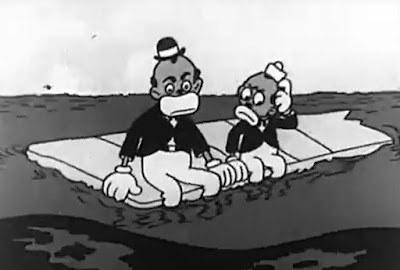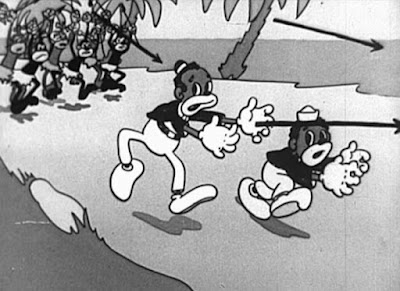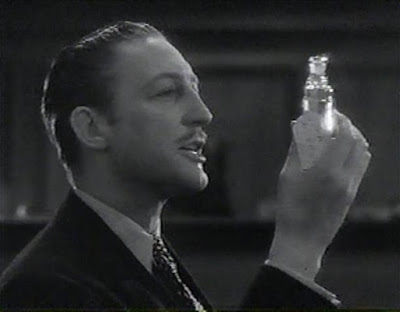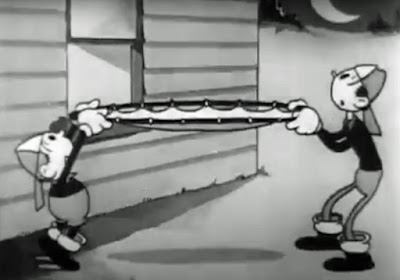Starring: F.E. Miller and Aubrey Lyles
Directors: John Foster and George Rufle
Rating: Four of Ten Stars
While trying to circumnavigate the globe in a plane, Tom & Jerry (Miller and Lyles) crash in the ocean near Africa. Disguised as black people, they hope to blend in with the natives... with predictable results.
While trying to circumnavigate the globe in a plane, Tom & Jerry (Miller and Lyles) crash in the ocean near Africa. Disguised as black people, they hope to blend in with the natives... with predictable results.
I've been putting off reviewing "Plane Dumb" for quite some time. I decided to post about all the "Tom & Jerry" cartoons here at Shades of Gray, partly because I wasn't clear on how I would accurately describe something that's both innovative and absolutely awful at the same time; it goes in a direction that no other entries in the series go... but it is also terribly stupid and inexplicably racist in so many ways that it must have even surprised many audience members even back in 1932.
It turns out that putting this one off was a Good Thing, because a little research and reading the excellent book by Hal Erickson about the Van Beuren productions gave me insight into how "Plane Dumb" came to be that softened by stance as a reviewer (but not necessarily as a viewer): The fact is that this cartoon didn't start out as "Tom & Jerry" cartoon goes a long way to explain a number of its flaws.
According to Erickson's book, and other sources, the Tom & Jerry cartoon we know as "Plane Dumb" actually began production as "All Wet". There is some speculation that it may have been intended as part of a series featuring animated versions of the popular African-American comedy team Miller & Lyles, but the project fell apart... most likely due to Aubrey Lyles' death shortly after voice work on "All Wet" is believed to have been completed. Not wanting effort (and money) to go to waste, Van Beuren seems to have had the existing footage and recorded dialog from Miller & Lyles combined with an ill-considered opening scene where Tom and Jerry transform themselves into two black guys.
Anyone who's seen more than one "Tom & Jerry" installment before this one--and who paid attention--will find their transformation baffling and annoying. Unlike what some commentators may lead you to believe, Tom & Jerry did actually have distinct personalities. Through all the ups and downs of inconsistent quality across the various installments, you could always count on Tom to be the more grounded and cautious (even cowardly on many occasions) of the two, while Jerry is an aggressive risk-taker whose actions often create more chaos than is good for anyone. In "Plane Dumb", however, their personalities have inexplicably changed--inexplicable until you learn that this tall and short duo were never intended to be Tom & Jerry. The personalities exhibited line up with the characters usually portrayed by Miller and Lyles, with the tall one being the aggressor and the short one being the reactor, so, given the fact these characters weren't originally Tom & Jerry. (Actually, what I am saying is not completely accurate; when it comes right down it, both Tom and Jerry are somewhat cowardly, but overall, their personalities are reversed when considered in the context of the overall series.)
Part of me wants to excuse the shift in personalities, because, back before I realized that this cartoon is a patchwork of fresh and recycled material, I thought it was something of an innovation for the series: Most "Tom & Jerry" cartoons might as well be silent films there is so little meaningful dialog--but here there are back-and-forth comedy routines, spoken jokes, and puns that tie into visual gags. It was an amazing departure for an entry in this series--which, of course, is because most of the material here didn't start out as a "Tom & Jerry" episode--but even apart from that, "Plane Dumb" is remarkable because of the nature of the dialog.
Few cartoons were driven by spoken exchanges in the early 1930s, so it was quite remarkable that Van Beuren teamed up with a pair of comedians known for their verbal back-and-forths for what COULD have been a bit of trail-blazing. The Miller & Lyles bits are interspersed among the usual surreal, visual nonsense consumers of Van Beuren cartoons would be accustomed to, but the main driver was the dialog.
Why Van Beuren's deal with Miller & Lyles fell apart remains unknown to me. I found a couple explanations, but nothing solid. One suggestion is that the pair were simply too busy and broke the contract, while another posited that they were unhappy with the quality Van Beuren's animators were producing, as well as the rate at which the pair was being paid. Either explanation seems plausible to me. At the end of it all, what we're left with is a cartoon that's equal parts awful and innovative... and one that has NOT aged well. The bits with Tom and Jerry stranded at sea and their battle with the creatures there is fun (even if the bit with the octopus is a bit of headscratcher), but it's mostly downhill from there... with rock-bottom being our heroes fleeing from hostile African natives who are literally spear-chuckers.
The Four Rating I'm assigning "Plane Dumb" is the lowest possible, and even that may be generous--and it's entirely because of the innovative nature of the use of dialog. It's interesting to consider if this cartoon had seemed as outrageously racist if whatever the original set-up that caused Miller & Lyles' fast-talking jokesters crash their plane in the ocean had been intact. Would it have seemed less racist?
"Plane Dumb" is the worst entry in the "Tom & Jerry" series. I can't recommend watching it, but I am embedding it below anyway, so you can form your own opinion. (And if it differs from mine, I hope you leave a comment to tell the world what it is.)


































.jpg)






.jpg)
